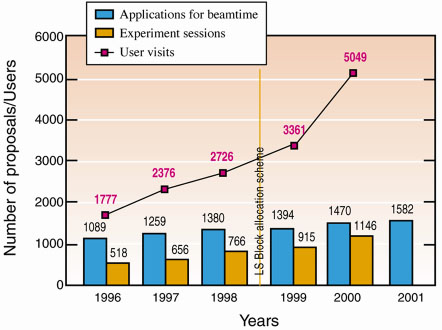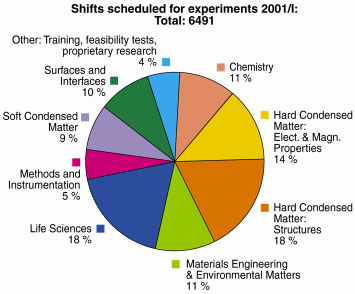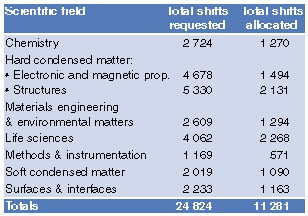User Operation
During the year 2001 the full complement of 30 public beamlines, together with 8 additional beamlines operated by Collaborating Research Groups (CRGs), were open for user experiments. Requests for beam time, and the numbers of users carrying out experiments continued to increase, this can be seen in Figure 196. This figure shows the number of applications for beam time and experiments carried out, together with numbers of scientists' visits since 1996.
 |
Fig. 196: Numbers of applications for beam time, experiments carried out, and user visits, 1996 to 2001. N.B. final numbers of experiments and user visits for 2001 were not available at the time of going to press. |
Proposals for experiments are selected and beam time allocations are made through peer review. Review Committees of specialists from European countries, Israel and the rest of the world have been set up in the following scientific areas:
- chemistry
- hard condensed matter: electronic and magnetic properties
- hard condensed matter: structures
- materials engineering and environmental matters
- life sciences
- methods and instrumentation
- soft condensed matter
- surfaces and interfaces
The Review Committees met twice during the past year, some six weeks after each deadline for submission of proposals (1 March and 1 September). They reviewed a total of 1582 applications for beam time, and selected 745 (47%), which were then scheduled for experiments.
Features of this period have been the increasing number of projects concerned more with applied than basic research in materials science, engineering and environmental matters. As shown in Figure 197, experiments in these areas accounted for 11% of the total number of experiments carried out in the first half of 2001. In addition, for the life sciences, the number of macromolecular crystallography experiments has risen notably. This is due to a combination of the availability of five experimental stations dedicated to macromolecular crystallography, very rapid data collection times frequently less than one shift - and the very successful operation of the Block Allocation Group (BAG) scheme, designed to encourage groups of users to block together their multiple requests for beam time, and the scheduling of their experiments. As an indication, the number of BAGs, initially 20 late in 1998, rose to 38 by the second scheduling period in 2001.
 |
Fig. 197: Shifts scheduled for experiments, from February to July 2001, by scientific area. |
Requests for beam time, which is scheduled in shifts of 8 hours, totalled 24 824 shifts or 198 592 hours for the year, of which 11 281 shifts or 90 248 hours (45%) were allocated; the distribution of shifts by scientific area is shown in Table 12.
 |
Table 12: Number of shifts of beam time requested and allocated for user experiments, year 2001. |
The first half of 2001 saw 2 051 visits by scientists to the ESRF under the user programme, to carry out 530 experiments. This dramatic rise in the number of users visits since 1999 reflects the increase in the number of experiments carried out overall, and in particular multiple visits by macromolecular crystallography BAG teams. The breakdown of experiments carried out, by scientific area, is shown in Figure 197.
The number of users in each experimental team averaged 3.9 persons, and they stayed for some 3 days. Users responding to questionnaires indicate that they particularly appreciate the assistance they receive from scientists and support staff on beamlines, and smooth administrative arrangements, in addition to the quality both of the beam and of the experimental stations. Facilities on site, such as preparation laboratories, a library, a canteen, and the guesthouse, also make an important contribution to the quality of user support.
On the beamlines, beam time losses tended to occur because of occasional difficulties with the beamline components or with samples. Such beam time losses, however, remained below 5% of the total shifts scheduled for experiments during the period.



